|
||||||
|
DORYCNIUM. Canary Clover. [Fabaceae] |
|
Two species of Dorycnium are recorded in Britain. Four British miners are recorded on Dorycnium. A key to the European miners recorded on Dorycnium is provided in Bladmineerders van Europa. |
|
Key for the identification of the known mines of British |
1a > Leaf-miner and case-bearer: The larva lives outside the mine, protected by a case, and feeds on the underlying plant tissues via a hole cut in the epidermis. From that point it eats away as much leaf tissue as it can reach without fully entering the mine. Mine does not contain frass (Coleophora species). |
1b > Leaf-miner, but not a case-bearer: The larva lives mainly inside the mine. Mine usually contains frass. In later instars the larva may live sandwiched between two more or less circular sections cut from the leaf. |
2 > Leaf-miner and case-bearer: The initial mine is like that of a nepticulid. The case is made form excised leaf portions, which are added to the oral end, leading to the ringed appearance. The larva causes the leaf to have white blotches. Identification cannot be made on these alone as similar blotches can be made by early instar larvae of the Common Blue butterfly (Polyommatus icarus). Oviposition at the leaf underside, mostly in a vein axil. The larva begins by making a narrow winding corridor with much frass in a broad central line. The corridor reminds that of a nepticulid (but the egg has a finely reticulate surface, unlike the smooth nepticulid egg.) In the end the corridor widens into an oval blotch, usually close to the leaf margin, out of which the first case is made. The full grown larva in a greyish brown composite leaf case of about 6 mm, attached to the underside of a leaf. The oldest quarter of the case is bivalved, laterally compressed, and is at an angle of 70° with the anterior part of the case. The mouth angle is around 40°. |
|
? Coleophora discordella Zeller, 1849 [Lepidoptera: Coleophoridae]. |
3a > Leaf-miner: The first generation initially forms an unmistakable leaf-mine on Anthyllis vulneraria, but the second generation feeds on the flowers. Feeding signs on other plants vary in appearance. Larvae can move between sewn leaves, and more than one larva may be found together. Larvae in a small full depth blotch, often with extensions. Frass concentrated in one corner of the mine. The mining activities may cause the leaf to roll inwards. Older larvae live free among spun leaves, but still they may make then full depth mines by feeding on the leaf tissue from a small opening. |
 Aproaerema anthyllidella larva, dorsal Image: © Steve Wullaert (Bladmineerders van Europa) |
|
Aproaerema anthyllidella (Hübner, 1813) [Lepidoptera: Gelechiidae]. |
3b > Leaf-miner: The frass is arranged in a spiral and a circular blotch is formed. Egg at the underside of the leaf. The mine is an upper-surface blotch without anything like a preceding corridor. The blotch is about circular, but my have broad lobes. Black frass grains lie in indistinct arcs or spirals, glued to the upper epidermis, and forming a cark central patch. The larva can leave a mined leaf, and restart elsewhere. Pupation external. Cocoon spun beneath the leaf. |
|
Leucoptera lotella (Stainton, 1859) [Lepidoptera: Lyonetiidae]. |
3c > Leaf-miner: Egg at the upperside or underside of the leaf. The mine begins as a long narrow corridor with a linear frass line. The corridor abruptly widens into a blotch that in the end may occupy almost an entire leaflet. The blotch mostly starts at the base of the leaflet, and here also most frass is concentrated. Pupation generally within the mine; in rare cases the larva leaves the mine by an exit slit in the lower epidermis. |
|
Trifurcula eurema (Tutt, 1899) [Lepidoptera: Nepticulidae]. |
| Last updated 04-Jul-2019 Brian Pitkin | ||
